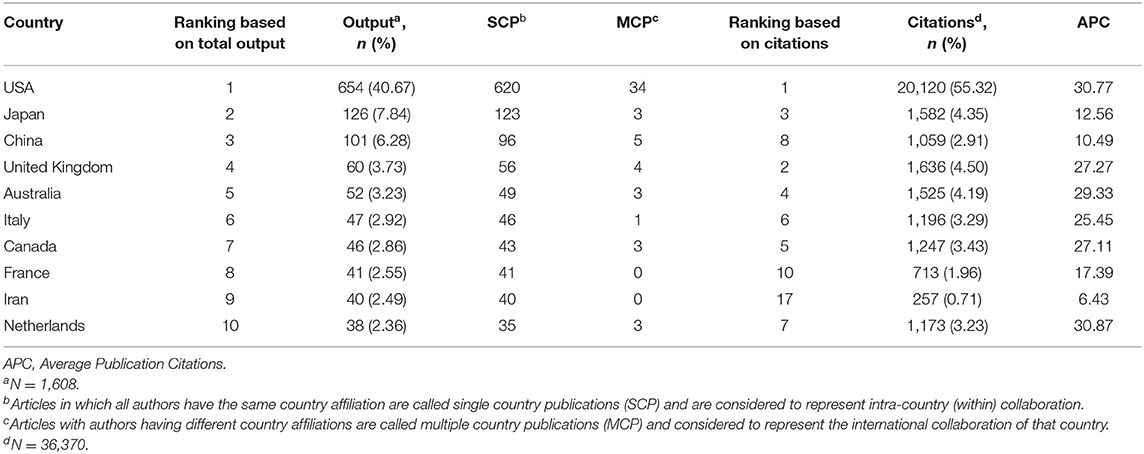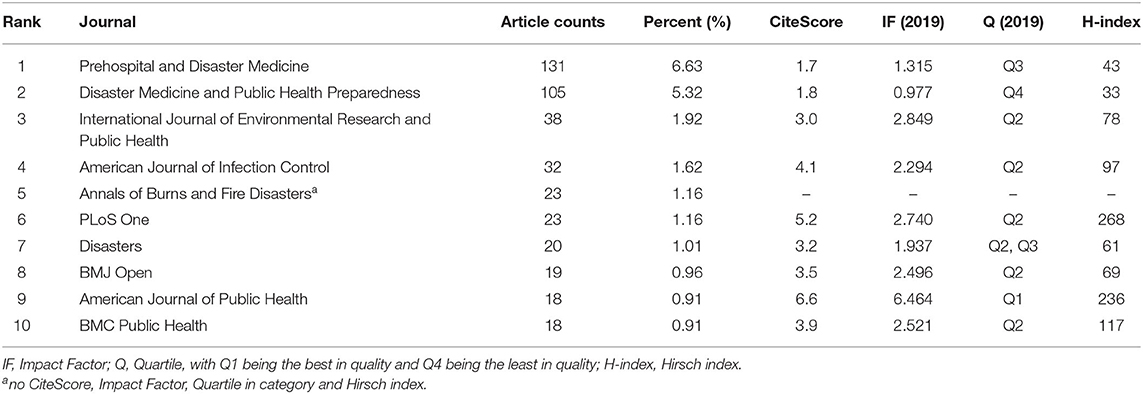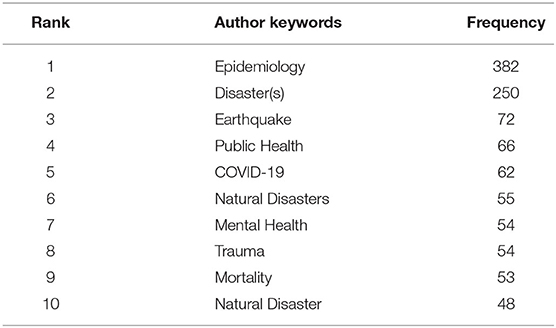- Institute of Disaster and Emergency Medicine, Tianjin University, Tianjin, China
Background: Disaster epidemiology has not attracted enough attention in the past few decades and still faces significant challenges. This study aimed to systematically analyze the evolving trends and research hotspots in disaster epidemiology and provide insights into disaster epidemiology.
Methods: We searched the Scopus and Web of Science Core Collection (WoSCC) databases between 1985 and 2020 to identify relevant literature on disaster epidemiology. The retrieval strategies were TITLE-ABS-KEY (disaster epidemiology) and TS = (disaster AND epidemiology). Bibliometrix, VOSviewer 1.6.6 and SigmaPlot 12.5 were used to analyze the key bibliometric indicators, including trends and annual publications, the contributions of countries, institutions, journals and authors, and research hotspots.
Results: A total of 1,975 publications were included. There was an increasing trend in publications over the past 35 years. The USA was the most productive country. The most frequent institutions and journals were Fukushima Medical University and Prehospital and Disaster Medicine. Galea S made significant contributions to this field. “Epidemiology” was the highest-frequency keyword. COVID-19 was highly cited after 2019. Three research hotspots were identified: (i) the short- and long-term adverse health effects of disasters on the population; (ii) COVID-19 pandemic and emergency preparedness; and (iii) disaster management.
Conclusions: In recent decades, the USA was a global leader in disaster epidemiology. Disaster management, the short- and long-term health effects of disasters, and the COVID-19 pandemic reflected the research focuses. Our results suggest that these directions will remain research hotspots in the future. International collaboration is also expected to widen and deepen in the field of disaster epidemiology.
Introduction
Disasters are one of the major threats facing our society's health today. A disaster is defined as “a serious disruption of the functioning of a community or a society causing widespread human, material, economic or environmental losses that exceed the ability of the affected community or society to cope using its own resources, thus necessitating a request to national or international level for external assistance” (1). In recent decades, the number of disasters has increased and led to, many deaths, injuries, diseases and disabilities (2, 3). Research on the health impacts of disasters has led to expanding use of epidemiological methods.
Epidemiology is the study of the distribution and determinants of disease and other health-related outcomes within populations (4). The application of epidemiology was applied in a disaster setting can produce estimates of the size of affected populations, quantify disaster-related morbidity, mortality and health outcomes (particularly the long-term effects), and provide evidence to demonstrate a causal relationship between exposures and health outcomes (5, 6). Disaster epidemiology is defined as the epidemiologic investigation of disaster forecasting and warning, emergency responses according to the different phases of disasters, and the short- and long-term adverse health effects of disasters on the population (7). Although disaster epidemiology is an evolving field, it still faces significant challenges (8).
Bibliometrics is a useful quantitative analysis approach to evaluate the quality and quantity of published papers (9) and can be used to explore the research trends, distribution of authorship, impact of publications and journals, and national and international contributions in a particular field (10–14). Bibliometric analysis has been applied to many fields, such as medicine, environmental health, computer science, and economics. Huang et al. (15) analyzed the state of research about the association of NO2, PM2.5 and noise exposure with cardiometabolic disorders. They identified three themes about research trends: the study of simultaneous exposures to multiple pollutants; the association between traffic-related pollutants and diabetes and metabolic symptoms; and the transition to the use of H-testing study designs to explore associations between noise and cardiometabolic outcomes. Guo et al. (16) provided a dynamic and longitudinal bibliometric analysis of healthcare-related artificial intelligence publications and reported that the major health problems studied in artificial intelligence research are cancer, depression, Alzheimer's disease, heart failure, and diabetes. Hao et al. (17) analyzed the development of disaster medicine to identify the main obstacles to improving disaster medicine research and application.
Disaster epidemiology scholars have published a substantial amount of research. However, the bibliometric profile of the disaster epidemiology literature is still unknown. Therefore, in this study, a bibliometric analysis was conducted to provide an overview of disaster epidemiology. This work identified current hotspots and estimated the contribution of leading countries, institutions, publishers, and researchers. The goal of the current study was to provide new perspectives for the further development of disaster epidemiology.
Materials and Methods
Data Sources and Search Strategy
We comprehensively searched the Scopus database and Web of Science Core Collection (WoSCC) database from 1985 to 2020 (5, 18, 19). Scopus is frequently used for bibliometric studies because, it is the largest abstract and citation database of peer-reviewed scientific literature (20, 21). We used the search strategy in the Scopus database as follows: [TITLE-ABS-KEY (disaster epidemiology) AND PUBYEAR > 1984 AND PUBYEAR <2021 AND (LIMIT-TO (DOCTYPE, “ar”) OR LIMIT-TO (DOCTYPE, “re”))]. Then, 1,686 publications related to disaster epidemiology were identified. WoSCC is an influential and multidisciplinary index database of academic literature abstracts worldwide that contains 10 sublibraries and is updated daily. We retrieved all documents from the WoSCC database using the following search strategy: [(TS = (disaster AND epidemiology) AND PY = 1985–2020)]. Regarding the document types, the search was restricted to only “article” and “review.” We retrieved 688 publications.
To avoid the bias caused by frequent database updates, we retrieved all literature and downloaded the data on the same day (March 14, 2021). Two investigators independently performed the search and had an agreement of 100% (kappa = 1 > 0.75), showing significant consistency (22). The expression was as follows:
In the present study, the inclusion and exclusion criteria were as follows: (i) all documents published between 1985 and 2020, including those published online, were included; (ii) only articles and reviews were included; (iii) all of the other document types, including editorial material, book reviews, retracted publications, proceedings papers, meeting abstracts, early access, corrections, news items, letters, book chapters and reprints, were excluded; and (iv) duplicate publications were excluded. Finally, a total of 2,374 publications were extracted from the two databases. The data, including titles, author information, abstracts, keywords, journals, and references, were downloaded in bib format.
Data Analysis and Data Visualization
In the present study, the data analysis is divided into three substages. The first is to merge the databases. We merged the two databases and removed duplicate bibliographies (23–25). A total of 399 duplicates were deleted; therefore, the merged database included 1,975 publications (Figure 1). To control this process, we converted both WoSCC.bib and Scopus.bib to “bibtex” files. All analyses were performed using R (Version 4.0.4) and RStudio (Version 1.4.1106).
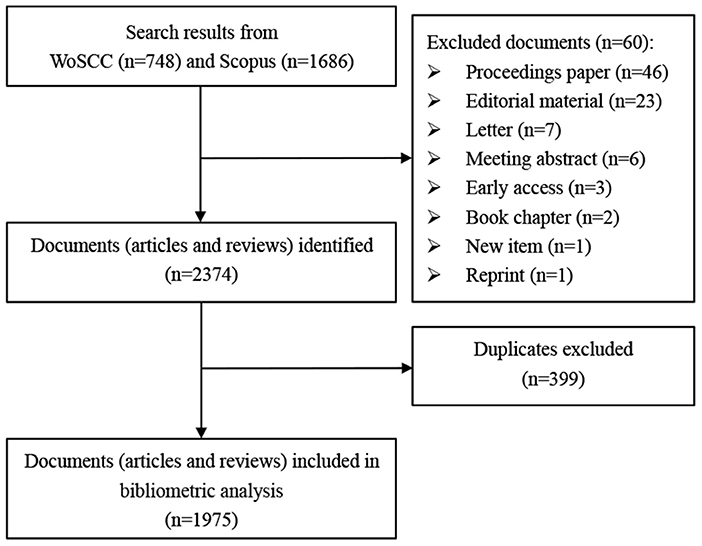
Figure 1. Flow chart detailing the paper collection and screening process. WoSCC, Web of Science Core Collection.
The second substage is descriptive analysis. The key bibliometric indicators were analyzed using Bibliometrix, an R package (23, 24), and they included the following: the annual trend of publications, most relevant keywords, most productive countries, journals, and authors, among others.
The final substage is data visualization. Sigmaplot (Version 12.5) was used to plot the time trend of publications. Map construction and visualization were conducted using the VOSviewer (Version 1.6.6) package program. In the network visualization, different colors represent different clusters, such as countries, authors and institutions; connecting lines represent parameters such as collaboration and cocitation. The size of the circle represents the magnitude of the correlation. The thickness of the connecting lines represents the collaboration strength (26–28).
Results
Trends and Annual Publications
Based on the merged databases, 1,975 publications (1,666 articles and 309 reviews) on disaster epidemiology from 1985 to 2020 were included in the final analysis, and 91.95% were in English (Supplementary Tables 1, 2).
A vast increase in publication number was observed over this period, with annual publications growing from 15 in 1985 to 215 in 2020 (Figure 2). According to the publication number, this period was preliminarily divided into three stages: Stage 1, from 1985 to 2002, was considered as the initial period, when almost <30 papers were published annually and the average papers per year were 17.00; Stage 2, from 2003 to 2013, was known as the development period, with an average annual paper of 57.36, and the maximum number of annual publications was obtained in 2007 at 84; and. Stage 3, from 2014 to 2020, was the “boom period,” when the annual number of papers increased rapidly, with 1,038 documents being published (~53.00% of the total publications) and an annual average number of 148.29 (Figure 2). Among them, 38.60% (83/215) of the papers were related to disaster epidemiology and COVID-19 in 2020. Based on the Scopus and WoSCC databases, 1,975 papers were cited 41,302 times, and each paper was cited an average of 20.91 times.
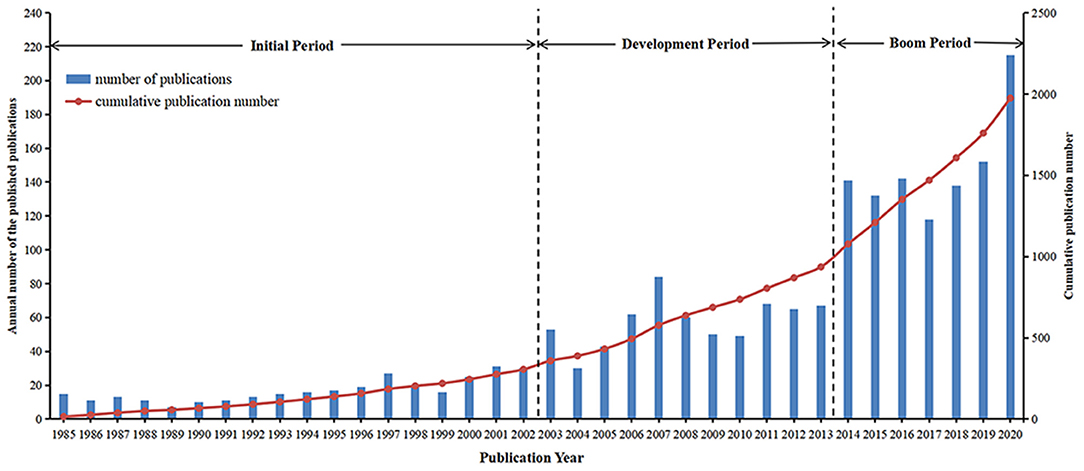
Figure 2. Annual number of the published publications and cumulative publication number on disaster epidemiology research from 1985 to 2020. “Annual number of published publications” is referred to the left axis and “cumulative publication number” to the right axis.
Contribution of Countries and Institutions
In this study, 86 countries and 3,554 institutions contributed to publications on disaster epidemiology between 1985 and 2020. Table 1 presents the top 10 most productive countries by the corresponding authors' origin. The USA published the greatest number of documents (654, 40.67%). Japan was the next leading country (126, 7.84%), followed by China (101, 6.28%). When countries were ranked based on multiple country publications (MCPs) (29), only the USA had a high percentage of papers. Publications from the USA had the highest share of citations (20,120, 55.32%). Publications from the Netherlands had the highest average citation per publication (30.87), followed by the USA (30.77).
The country coauthorship analysis indicated the degree of communication between the influential countries in this field (30). The map (Figure 3A) included 30 nodes. Researchers from the USA showed the highest collaboration performance, with a total link strength of 3,366, followed by the United Kingdom (total link strength = 1,242) and Australia (total link strength = 1,193).
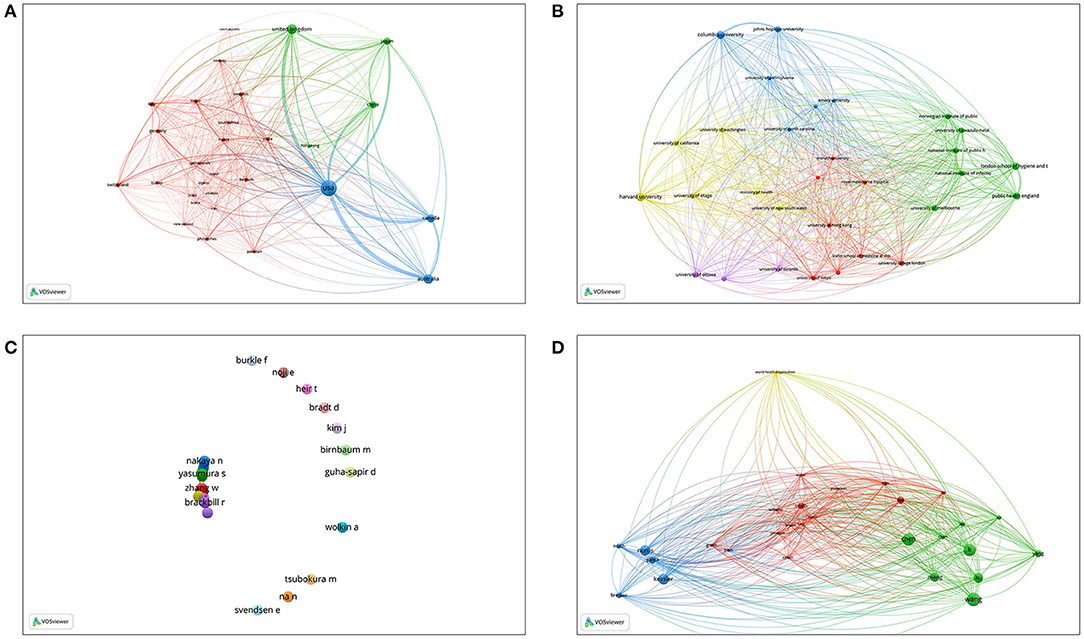
Figure 3. Network visualization map for (A) country collaboration, (B) institution collaboration, (C) author co-authorship, and (D) author co-citation.
Regarding the 10 most frequent institutions, Fukushima Medical University in Japan was the leading research institution, followed by Tohoku University in Japan and California University in the USA (Supplementary Table 3). Six are located in the USA, two are located in Japan, one is located in the Philippines, and one is located in Iran. Among all institutions included in the studies, 2,511 institutions published only one article, and 17 institutions published 20 or more articles (Supplementary Figure 1A). Approximately 60% of institutions have published 80% of publications in this field (Supplementary Figure 1B). The institution collaboration network is shown in Figure 3B. The most collaborative organizations included the following: Columbia University (total link strength= 72), Harvard University (total link strength= 70), and London School of Hygiene and Tropical Medicine (total link strength= 65), among others.
Contribution of Journals
From 1985 to 2020, 903 journals contributed to the disaster epidemiology field. We comprehensively analyzed the characteristics of the top 10 most productive journals, including journal titles, article counts, the percentage of articles, CiteScore (2019), impact factor (IF) (2019), quartile in category (2019), and Hirsch index (h-index). As demonstrated in Table 2, these journals published 427 papers, accounting for 21.62% of the total publications. Prehospital and Disaster Medicine published the most papers, followed by Disaster Medicine and Public Health Preparedness and International Journal of Environmental Research and Public Health. The American Journal of Public Health had the highest IFs of any journals in 2019. The highest CiteScore also belonged to the American Journal of Public Health. The highest h-index was PLoS One. Among these, only the American Journal of Public Health was classified as Q1 according to the JCR 2019 standards.
The top 10 most highly cited publications contributed to 13.74% (5,674/41,302) of the total citations (Supplementary Table 4). The papers published in the Journal of Consulting and Clinical Psychology, New England Journal of Medicine, and Epidemiologic Reviews were the most cited (1,443 vs. 921 vs. 737 citations, respectively). Of the top 10 highly cited papers, two were published in the New England Journal of Medicine (IF = 74.699), and one was published in the Lancet (IF = 60.392) (31–33).
Analysis of Research Hotspots
A topic dendrogram (Figure 4A), trends of top keywords (Figure 4B), and topic trend plot (Figure 4C) were generated. With an appearance of more than 25 times, the 23 most frequent keywords were extracted from the included publications. Of these, the top 10 keywords are listed in Table 3. “Epidemiology” and “disaster(s)” were the most frequent keywords, followed by “earthquake” and “public health.” Figure 4B documents the J-shaped curves for “epidemiology” and “disaster(s),” with sustained growth from 1985 to 2020. The most recent was COVID-19, with a frequency of 62, which was highly cited after 2019 (Figure 4B; Table 3).
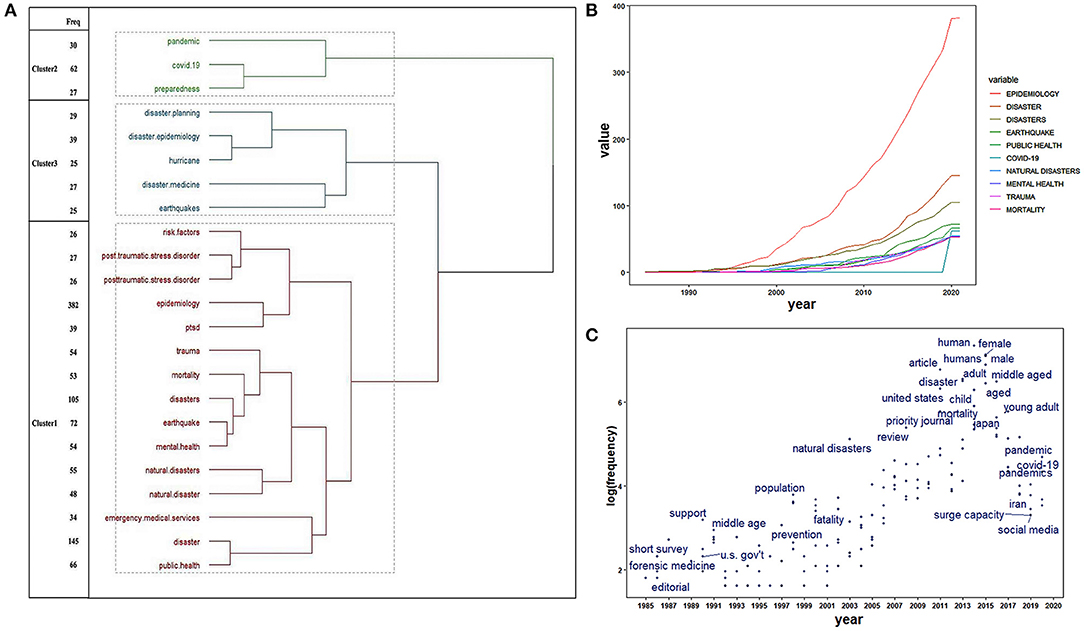
Figure 4. Research hotspot tendencies in the field of disaster epidemiology. (A) Topic dendrogram based on author keywords. (B) The occurrences of top author keywords annually. (C) The trend topics based on the keywords-plus.
To further explore the changes in hotspots, the above 23 high-frequency keywords were sorted into three clusters using the R package. The representative articles involved in each cluster were mined to further summarize hotspots in the field of disaster epidemiology. Finally, 3 hotspots were identified (Figure 4A):
Cluster 1: Short- and long-term adverse health effects of disasters on the population;
Cluster 2: COVID-19 pandemic and emergency preparedness;
Cluster 3: Disaster management.
Hotspots have shifted from natural disasters to human health effects (e.g., mortality, posttraumatic stress disorder, etc.) exposure to natural disasters and man-made disasters. The most recent research hotspots were COVID-19 and the pandemic (Figure 4C). After the initial emergency responses are deployed to control the COVID-19 pandemic, we should start thinking about long-term strategies and concepts for pandemic and disaster governance, such as resilience.
Contribution of Authors
In the present study, a total of 8,139 authors were counted. In terms of the most productive authors, Galea S ranked first with 24 publications, followed by Rebmann T with 20 publications and Li J with 18 publications (Supplementary Table 5). Galea S also had the highest local citations of 43. However, Na N ranked first as the first author, and Galea S ranked fourth among others.
Figure 3 also shows the network visualization map for author coauthorship and author cocitation on disaster epidemiology. Yasumura S had the largest total link strength of 279 (Figure 3C). Remarkably, the cooperation between the authors was relatively weak on the whole. Wang also made significant contributions to the field of disaster epidemiology, with the largest total link strength of 9,634 and links of 27 (Figure 3D).
Discussion
During the present information explosion, bibliometric analysis can help scientific researchers visualize knowledge structures and recognize hotspots in a research field (34–36). Our study provides the most upto-date analysis of annual publication trends, the contribution of countries, institutions, journals and authors, and the research hotspot tendencies related to disaster epidemiology from 1985 to 2020.
Trends and Annual Publication
A relatively slow increase in disaster epidemiology was observed from 1985 to 2020. However, since 2003, the pace of moving forward in this field has experienced the first shift. In 2014, the research ushered in a new era. The cause of these shifts was multifactorial. Disaster epidemiology may date to the 1970s. Epidemiological principles and methods began to be used in disaster response in the 1980s and had a general picture in the 1990s (5). Severe acute respiratory syndrome (SARS), defined as a disaster, broke out in late 2002 and early 2003, sickened more than 8,000 people, and spread to more than 30 countries within 6 months (37–39). The SARS pandemic has drawn the world's further attention to disaster epidemiology. Ten years later, Middle East respiratory syndrome (MERS) emerged in Saudi Arabia and spread to ~27 different countries with a fatality rate of 37% (40–42). The novel coronavirus (COVID-19) epidemic is a newly emerging infectious disease that was identified in China in late 2019, rapidly spreading to many countries and posing a major threat to public health (43–45). To explore the epidemic and impact of COVID-19, epidemiological methods were applied to model the COVID-19 pandemic (46, 47). This is why research on disaster epidemiology has increased rapidly in 2020. The epidemic and impact of COVID-19 also belong to the research scope of disaster epidemiology. This disaster highlighted the paramount importance of the practical application of epidemiological methods (48).
According to the growing trend of disaster epidemiology research, the publication volume will continue to grow linearly until the theory is mature. With the advent of COVID-19, we can estimate that research in this field will experience a large leap in the next several years (49).
Publication Patterns
The field of disaster epidemiology has attracted people from all around the world, and developed countries are the main driving force, while developing countries have a limited effect. Multiple barriers, including funding, prioritization, research capacity, infrastructure, and language, contribute to these disproportionate results. Developing countries have limited resources, while developed countries allocate greater resources to this area and draw more interest from scientists. The USA contributed to most of the research and was the most active country and closely cooperated with many countries, playing an irreplaceable leading role in the field of disaster epidemiology. To shed light on the most active institutions, journals, and authors of a field are essential. Tracking the research trends of these institutions, journals, and authors will enable us to quickly grasp the research frontiers on disaster epidemiology (50). Collaborative regions, institutions, and authors were correlated geographically (51). Nevertheless, there is a lack of international cooperation with each other. The collaboration between authors is weaker, with no obvious major specialist groups. Under the general trend of cooperation, it is necessary for us to strengthen interdisciplinary and multidisciplinary cooperation. The investigation of top-cited papers can certainly help track high-impact journals, which identify research directions and complement the current body of knowledge. It is worth mentioning that the top-cited papers were focused on traumatic catastrophic events and their impact.
Analysis of Research Hotspots
Based on the growing number of disaster epidemiology publications, the theoretical system, and methods of disaster epidemiology are gradually improving. Keywords reflect the concerns of the authors and their papers, which provides a general idea of research activity (52–54). The main domains of disaster epidemiology were epidemiology, disaster(s), earthquakes, public health and COVID-19. It is urgent to comprehensively assess the national health burden in disasters (e.g., earthquakes, floods, new infectious diseases) (55). Given the destructive and potential impacts of natural disasters, the threat of terrorism and the sheer unpredictable variants, disaster epidemiology can play an important role in controlling and mitigating the disaster's effects (55–58).
Disaster epidemiological methods can provide information about the health effects as well as resource allocation of social and community, manage the reports of social media, gauge medical needs, and assess impacts on health care systems in disaster settings (59). These methods have been applied to assess the scope and distribution of public health problems. Collecting epidemiological information in real time and practicing epidemiological methods throughout disasters contributes to disaster rescue and reduction of health burden (5).
Nearly all disasters carry a substantial public health risk and require both immediate and long-term assessment of their health effects on the population (55, 60, 61). However, significant challenges remain in disaster epidemiology as an evolving field (62). The COVID-19 pandemic has thrust epidemiologists and epidemiological models into the policy and media spotlight like, as never before, which highlights the importance of disaster epidemiology (56, 63). With the expansion of research activities, disaster epidemiology has also been further enriched. Bibliometric analysis may be a significant guide for tracking the growth in disaster epidemiology (64).
In the last 35 years, the times and lengths of citation bursts of each research topic on disaster epidemiology have varied. Certain keywords were extraordinarily consistent for a long period, while some keywords only briefly surged (16). Our study found that epidemiology and disaster(s) consistently acquired a high focus from 1985 to 2020. The COVID-19 pandemic, which broke out at the end of 2019, led to the dawn of a new era for the disaster epidemiology field (65). The frequency of COVID-19 in the literature was sharply increased.
Disaster epidemiology research has experienced several shifts in recent decades and continues to shift. We found that research hotspots have shifted from natural disasters to human health effects (e.g., mortality, posttraumatic stress disorder, etc.) exposure to natural disasters and man-made disasters. The most recent research hotspots were COVID-19 and the pandemic. The sustainability of research clusters related to disaster epidemiology is affected by the development of emergencies and public health events. Research related to disasters (e.g., earthquakes, floods, etc.) management and the short- and long-term adverse health effects of disasters on the population sustained a hotspot over the past decades, whereas some clusters were relatively short-lived, such as SARS. In particular, the COVID-19 pandemic and emergency preparedness have remained research hotspots since 2019. These research domains exert strong impacts on the field, and their influence will likely continue in the next few years (49). This information will provide directions for advancing the development of disaster epidemiology.
Limitations
This study presented the bibliometric data from 1,975 publications on disaster epidemiology extracted from the merged database (WoSCC database and Scopus database) between 1985 and 2020. Even though the data analysis of this study was relatively objective and comprehensive, it also has limitations. First, bibliometric data change with time, and different conclusions may be drawn with time. Therefore, this study should be updated in the future. Second, there exists a discrepancy between the results of bibliometric analysis and the real research situation, which is due to the database remaining open as it continuously updates studies. In this case, the bibliometric analysis may not reflect the real situation.
Conclusions
This study aimed to provide a basic overview of research publications on disaster epidemiology published between 1985 and 2020. The number of publications presented a trend of continuous growth, and developed countries are the main force of this field. The hotspots of research on disaster epidemiology are closely related to the development of emergencies and public health events. Research related to disaster management and the short- and long-term adverse health effects of disasters on the population will be hotspots. The COVID-19 pandemic and emergency preparedness will also gain more attention. These research domains will likely continue in the next few years and exert strong impacts on advancing the development of disaster epidemiology. These results provide new perspectives for the study of disaster epidemiology and may have a beneficial effect on further study regarding the development of disaster epidemiology and possible practice implications.
Data Availability Statement
The original contributions presented in the study are included in the article/Supplementary Material, further inquiries can be directed to the corresponding author/s.
Author Contributions
CC and TL conceptualized and designed the study and drafted the article. XL and TL independently performed the search databases. TL, YL, and SL contributed to the analysis and interpretation of data. CC, TL, and YL reviewed and revised the article critically for important intellectual content. CC takes responsibility for the paper as a whole. All authors approved the final article and agreed to be accountable for all aspects of the work.
Funding
This work was supported by the National Key Research and Development Program of China (Grants Nos. 2018YFC1603706 and 2019YFC1606304).
Conflict of Interest
The authors declare that the research was conducted in the absence of any commercial or financial relationships that could be construed as a potential conflict of interest.
Publisher's Note
All claims expressed in this article are solely those of the authors and do not necessarily represent those of their affiliated organizations, or those of the publisher, the editors and the reviewers. Any product that may be evaluated in this article, or claim that may be made by its manufacturer, is not guaranteed or endorsed by the publisher.
Supplementary Material
The Supplementary Material for this article can be found online at: https://www.frontiersin.org/articles/10.3389/fpubh.2021.720787/full#supplementary-material
References
1. Xia YJ, Xia H, Chen L, Ying QS, Yu X, Li LH, et al. Efficient delivery of recombinant human bone morphogenetic protein (rhBMP-2) with dextran sulfate-chitosan microspheres. Exp Ther Med. (2018) 15:3265–72. doi: 10.3892/etm.2018.5849
2. Messeri A, Morabito M, Messeri G, Brandani G, Petralli M, Natali F, et al. Weather-related flood and landslide damage: a risk index for Italian regions. PLoS One. (2015) 10:e0144468. doi: 10.1371/journal.pone.0144468
3. Leaning J, Guha-Sapir D. Natural disasters, armed conflict, and public health. N Engl J Med. (2014) 370:783–4. doi: 10.1056/NEJMc1315507
4. Jeffries WL, Henny KD. From epidemiology to action: the case for addressing social determinants of health to end HIV in the Southern United States. AIDS Behav. (2019) 23(Suppl. 3):340–6. doi: 10.1007/s10461-019-02687-2
5. Malilay J, Heumann M, Perrotta D, Wolkin AF, Schnall AH, Podgornik MN, et al. The role of applied epidemiology methods in the disaster management cycle. Am J Public Health. (2014) 104:2092–102. doi: 10.2105/AJPH.2014.302010
6. Thorpe LE, Assari S, Deppen S, Glied S, Lurie N, Mauer MP, et al. The role of epidemiology in disaster response policy development. Ann Epidemiol. (2015) 25:377–86. doi: 10.1016/j.annepidem.2014.05.016
7. Du Y, Ding Y, Li Z, Cao G. The role of hazard vulnerability assessments in disaster preparedness and prevention in China. Mil Med Res. (2015) 2:27. doi: 10.1186/s40779-015-0059-9
8. Jurek AM, Maldonado G. Quantitative bias analysis in an asthma study of rescue-recovery workers and volunteers from the 9/11 World Trade Center attacks. Ann Epidemiol. (2016) 26:794–801. doi: 10.1016/j.annepidem.2016.09.002
9. Dai L, Zhang N, Rong L, Ouyang YQ. Worldwide research on fear of childbirth: a bibliometric analysis. PLoS One. (2020) 15:e0236567. doi: 10.1371/journal.pone.0236567
10. Guler AT, Waaijer CJ, Palmblad M. Scientific workflows for bibliometrics. Scientometrics. (2016) 107:385–98. doi: 10.1007/s11192-016-1885-6
11. Yang G, Wu L. Trend in H2S biology and medicine research-a bibliometric analysis. Molecules. (2017) 22:2087. doi: 10.3390/molecules22122087
12. Jiang Y, Hu R, Zhu G. Top 100 cited articles on infection in orthopaedics: a bibliometric analysis. Medicine (Baltimore). (2019) 98:e14067. doi: 10.1097/MD.0000000000014067
13. Yang DW, Wang XP, Wang ZC, Yang ZH, Bian XF. A scientometric analysis on hepatocellular carcinoma magnetic resonance imaging research from 2008 to (2017). Quant Imaging Med Surg. (2019) 9:465–76. doi: 10.21037/qims.2019.02.10
14. Sweileh WM, Al-Jabi SW, AbuTaha AS, Zyoud SH, Anayah FMA, Sawalha AF. Bibliometric analysis of worldwide scientific literature in mobile-health: 2006-2016. BMC Med Inform Decis Mak. (2017) 17:72. doi: 10.1186/s12911-017-0476-7
15. Huang YK, Hanneke R, Jones RM. Bibliometric analysis of cardiometabolic disorders studies involving NO2, PM2.5 and noise exposure. BMC Public Health. (2019) 19:877. doi: 10.1186/s12889-019-7195-1
16. Guo Y, Hao Z, Zhao S, Gong J, Yang F. Artificial intelligence in health care: bibliometric analysis. J Med Internet Res. (2020) 22:e18228. doi: 10.2196/18228
17. Hao X, Liu Y, Li X, Zheng J. Visualizing the history and perspectives of disaster medicine: a bibliometric analysis. Disaster Med Public Health Prep. (2019) 13:966–73. doi: 10.1017/dmp.2019.31
18. Tan HZ. The progress and trends of disaster epidemiologic study. Chin J Dis Control Prev. (2006) 10:395–400. doi: 10.3969/j.issn.1674-3679.2006.04.022 (in Chinese).
19. Seaman J. Disaster epidemiology: or why most international disaster relief is ineffective. Injury. (1990) 21:5–16. doi: 10.1016/0020-1383(90)90143-I
20. Garrido-Cardenas JA, Cebrián-Carmona J, González-Cerón L, Manzano-Agugliaro F, Mesa-Valle C. Analysis of global research on Malaria and Plasmodium vivax. Int J Environ Res Public Health. (2019) 16:1928. doi: 10.3390/ijerph16111928
21. López-Muñoz F, Povedano-Montero FJ, Chee KY, Shen WW, Fernández-Martín P, García-Pacios J, et al. A Bibliometric analysis of scientific production on second-generation anti-psychotic drugs in Malaysia. Malays J Med Sci. (2018) 25:40–55. doi: 10.21315/mjms2018.25.3.5
22. Kundel HL, Polansky M. Measurement of observer agreement. Radiology. (2003) 228:303–8. doi: 10.1148/radiol.2282011860
23. Echchakoui S. Why and how to merge Scopus and Web of Science during bibliometric analysis: the case of sales force literature from 1912 to 2019. J Market Anal. (2020) 8:165–84. doi: 10.1057/s41270-020-00081-9
24. Aria M, Cuccurullo C. Bibliometrix: an R-tool for comprehensive science mapping analysis. J Inf Lit. (2017) 11:959–75. doi: 10.1016/j.joi.2017.08.007
25. Olisah C, Adams JB. Systematic mapping of organophosphate contaminant (OPC) research trends between 1990 and (2018). Environ Geochem Health. (2020) 42:3481–505. doi: 10.1007/s10653-020-00594-3
26. Lapin M, Tjensvoll K, Oltedal S, Javle M, Smaaland R, Gilje B, et al. Single-cell mRNA profiling reveals transcriptional heterogeneity among pancreatic circulating tumour cells. BMC Cancer. (2017) 17:390. doi: 10.1186/s12885-017-3385-3
27. Ganasegeran K, Hor CP, Jamil MFA, Suppiah PD, Noor JM, Hamid NA, et al. Mapping the scientific landscape of diabetes research in Malaysia (2000-2018): a systematic scientometrics study. Int J Environ Res Public Health. (2021) 18:318. doi: 10.3390/ijerph18010318
28. Fu J, Jiang Z, Hong Y, Liu S, Kong D, Zhong Z, et al. Global scientific research on social participation of older people from 2000 to 2019: a bibliometric analysis. Int J Older People Nurs. (2021) 16:e12349. doi: 10.1111/opn.12349
29. Sweileh WM. Bibliometric analysis of literature on toxic epidermal necrolysis and Stevens-Johnson syndrome: 1940-2015. Orphanet J Rare Dis. (2017) 12:14. doi: 10.1186/s13023-017-0566-8
30. Zou LX, Sun L. Global diabetic kidney disease research from 2000 to 2017: a bibliometric analysis. Medicine (Baltimore). (2019) 98:e14394. doi: 10.1097/MD.0000000000014394
31. Helzer JE, Robis LN, Mcevoy L. Post-traumatic stress disorder in the general population. N Engl J Med. (1987) 317:1630–4. doi: 10.1056/NEJM198712243172604
32. McCord C, Freeman HP. Excess mortality in Harlem. N Engl J Med. (1990) 322:173–7. doi: 10.1056/NEJM199005313222213
33. GBD (2016). Mortality Collaborators. Global, regional, and national under-5 mortality, adult mortality, age-specific mortality, and life expectancy, 1970-2016: a systematic analysis for the Global Burden of Disease Study 2016. Lancet. (2017) 390:1084–150. doi: 10.1016/S0140-6736(17)31833-0
34. Deng Z, Wang H, Chen Z, Wang T. Bibliometric analysis of dendritic epidermal T cell (DETC) research from 1983 to 2019. Front Immunol. (2020) 11:259. doi: 10.3389/fimmu.2020.00259
35. Zhang X, Wang C, Zhao H. A bibliometric analysis of acute respiratory distress syndrome (ARDS) research from 2010 to 2019. Ann Palliat Med. (2021) 10:3750–62. doi: 10.21037/apm-20-2050
36. Hu Y, Yu Z, Cheng X, Luo Y, Wen C. A bibliometric analysis and visualization of medical data mining research. Medicine (Baltimore). (2020) 99:e20338. doi: 10.1097/MD.0000000000020338
37. Schwartz J, Yen MY. Toward a collaborative model of pandemic preparedness and response: Taiwan's changing approach to pandemics. J Microbiol Immunol Infect. (2017) 50:125–32. doi: 10.1016/j.jmii.2016.08.010
38. Castaño-Rodriguez C, Honrubia JM, Gutiérrez-Álvarez J, DeDiego ML, Nieto-Torres JL, Jimenez-Guardeño JM, et al. Role of severe acute respiratory syndrome coronavirus viroporins E, 3a, and 8a in replication and pathogenesis. mBio. (2018) 9:e02325–17. doi: 10.1128/mBio.02325-17
39. Rota PA, Oberste MS, Monroe SS, Nix WA, Campagnoli R, Icenogle JP, et al. Characterization of a novel coronavirus associated with severe acute respiratory syndrome. Science. (2003) 300:1394–99. doi: 10.1126/science.1085952
40. Zumla A, Hui DS, Perlman S. Middle East respiratory syndrome. Lancet. (2015) 386:995–1007. doi: 10.1016/S0140-6736(15)60454-8
41. Hui DS, Azhar EI, Kim YJ, Memish ZA, Oh MD, Zumla A. Middle East respiratory syndrome coronavirus: risk factors and determinants of primary, household, and nosocomial transmission. Lancet Infect Dis. (2018) 18:e217–e27. doi: 10.1016/S1473-3099(18)30127-0
42. Su S, Wong G, Liu Y, Gao GF, Li S, Bi Y. MERS in South Korea and China: a potential outbreak threat?. Lancet. (2015) 385:2349–50. doi: 10.1016/S0140-6736(15)60859-5
43. Baghernezhad Hesary F, Salehiniya H, Miri M, Moodi M. Investigating preventive behaviors toward COVID-19 among Iranian people. Front Public Health. (2021) 9:590105. doi: 10.3389/fpubh.2021.590105
44. Escribano P, Álvarez-Uría A, Alonso R, Catalán P, Alcalá L, Muñoz P, et al. Detection of SARS-CoV-2 antibodies is insufficient for the diagnosis of active or cured COVID-19. Sci Rep. (2020) 10:19893. doi: 10.1038/s41598-020-76914-5
45. Mo Y, Deng L, Zhang L, Lang Q, Liao C, Wang N, et al. Work stress among Chinese nurses to support Wuhan in fighting against COVID-19 epidemic. J Nurs Manag. (2020) 28:1002–9. doi: 10.1111/jonm.13014
46. Wang J. Mathematical models for COVID-19: applications, limitations, and potentials. J Public Health Emerg. (2020) 4:9. doi: 10.21037/jphe-2020-05
47. Singh RK, Rani M, Bhagavathula AS, Sah R, Rodriguez-Morales AJ, Kalita H, et al. Prediction of the COVID-19 pandemic for the top 15 affected countries: advanced autoregressive integrated moving average (ARIMA) model. JMIR Public Health Surveill. (2020) 6:e19115. doi: 10.2196/19115
48. Signorelli C, Fara GM. COVID-19: Hygiene and public health to the front. Acta Biomed. (2020) 91:7–8. doi: 10.23750/abm.v91i3-S.9507
49. Barcelo D. An environmental and health perspective for COVID-19 outbreak: meteorology and air quality influence, sewage epidemiology indicator, hospitals disinfection, drug therapies and recommendations. J Environ Chem Eng. (2020) 8:104006. doi: 10.1016/j.jece.2020.104006
50. Gao Y, Wang F, Song Y, Liu H. The status of and trends in the pharmacology of berberine: a bibliometric review [1985-2018]. Chin Med. (2020) 15:7. doi: 10.1186/s13020-020-0288-z
51. Zheng T, Wang J, Wang Q, Nie C, Shi Z, Wang X, et al. A bibliometric analysis of micro/nano-bubble related research: current trends, present application, and future prospects. Scientometrics. (2016) 109:53–71. doi: 10.1007/s11192-016-2004-4
52. Tang M, Liao HC, Wan ZJ, Herrera-Viedma E, Rosen MA. Ten years of sustainability (2009 to 2018): a bibliometric overview. Sustainability. (2018) 10:1655. doi: 10.3390/su10051655
53. Li LL, Ding GH, Feng N, Wang MH, Ho YS. Global stem cell research trend: bibliometric analysis as a tool for mapping of trends from 1991 to 2006. Scientometrics. (2009) 80:39–58. doi: 10.1007/s11192-008-1939-5
54. Zhang GF, Xie SD, Ho YS. A bibliometric analysis of world volatile organic compounds research trends. Scientometrics. (2010) 83:477–92. doi: 10.1007/s11192-009-0065-3
55. Reifels L, Mills K, Dückers MLA, O'Donnell ML. Psychiatric epidemiology and disaster exposure in Australia. Epidemiol Psychiatr Sci. (2019) 28:310–20. doi: 10.1017/S2045796017000531
56. How epidemiology has shaped the COVID pandemic. Nature. (2021). 589:491–2. doi: 10.1038/d41586-021-00183-z
57. Keim ME. The epidemiology of extreme weather event disasters (1969-2018). Prehosp Disaster Med. (2020) 35:267–71. doi: 10.1017/S1049023X20000461
58. Tovar MA, Bell RS, Neal CJ. Epidemiology of blast neurotrauma: a meta-analysis of blast injury patterns in the military and civilian populations. World Neurosurg. (2021) 146:308–14.e3. doi: 10.1016/j.wneu.2020.11.093
59. Noji EK. The public health consequences of disasters. Prehosp Disaster Med. (2000) 15:21–31. doi: 10.1017/S1049023X00025255
60. Kawakami N, Fukasawa M, Sakata K, Suzuki R, Tomita H, Nemoto H, et al. Onset and remission of common mental disorders among adults living in temporary housing for three years after the triple disaster in Northeast Japan: comparisons with the general population. BMC Public Health. (2020) 20:1271. doi: 10.1186/s12889-020-09378-x
61. Sakuma A, Ueda I, Shoji W, Tomita H, Matsuoka H, Matsumoto K. Trajectories for post-traumatic stress disorder symptoms among local disaster recovery workers following the Great East Japan Earthquake: group-based trajectory modeling. J Affect Disord. (2020) 274:742–51. doi: 10.1016/j.jad.2020.05.152
62. Oluyomi AO, Panthagani K, Sotelo J, Gu X, Armstrong G, Luo DN, et al. Houston hurricane Harvey health (Houston-3H) study: assessment of allergic symptoms and stress after hurricane Harvey flooding. Environ Health. (2021) 20:9. doi: 10.1186/s12940-021-00694-2
63. Verity R, Okell LC, Dorigatti I, Winskill P, Whittaker C, Imai N, et al. Estimates of the severity of coronavirus disease 2019: a model-based analysis. Lancet Infect Dis. (2020) 20:669–77. doi: 10.1016/S1473-3099(20)30243-7
64. Xu D, Luo P, Li S, Pfeifer R, Hildebrand F, Pape HC. Current status of helicopter emergency medical services in China: a bibliometric analysis. Medicine (Baltimore). (2019) 98:e14439. doi: 10.1097/MD.0000000000014439
Keywords: disaster epidemiology, bibliometric analysis, Scopus, web of science, hotspots, trends
Citation: Liu T, Liu X, Li Y, Liu S and Cao C (2021) Evolving Trends and Research Hotspots in Disaster Epidemiology From 1985 to 2020: A Bibliometric Analysis. Front. Public Health 9:720787. doi: 10.3389/fpubh.2021.720787
Received: 05 June 2021; Accepted: 09 August 2021;
Published: 30 August 2021.
Edited by:
Andy Wai Kan Yeung, The University of Hong Kong, ChinaReviewed by:
Aurelio F. Bariviera, University of Rovira i Virgili, SpainKhalid Z. Elwakeel, Jeddah University, Saudi Arabia
Copyright © 2021 Liu, Liu, Li, Liu and Cao. This is an open-access article distributed under the terms of the Creative Commons Attribution License (CC BY). The use, distribution or reproduction in other forums is permitted, provided the original author(s) and the copyright owner(s) are credited and that the original publication in this journal is cited, in accordance with accepted academic practice. No use, distribution or reproduction is permitted which does not comply with these terms.
*Correspondence: Chunxia Cao, caochunxia@tju.edu.cn
†These authors have contributed equally to this work and share first authorship
 Tao Liu
Tao Liu Xin Liu
Xin Liu Yue Li
Yue Li Shuyu Liu
Shuyu Liu Chunxia Cao
Chunxia Cao